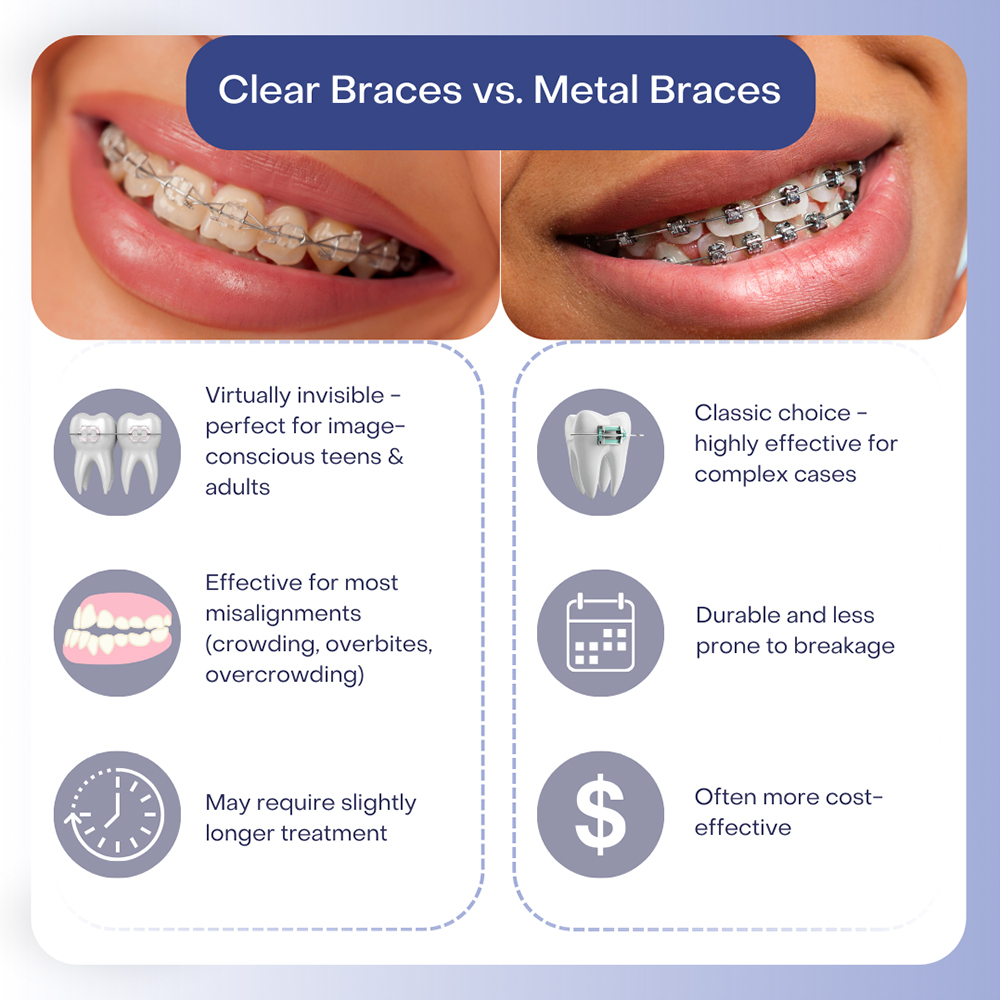Table of contents
For many, the thought of wearing braces conjures up an image of traditional metal braces. These use brackets, wires, elastics, and sometimes stainless steel bands to straighten teeth. Although extremely effective, metal braces are highly visible.
Clear braces work similarly, but they have clear or ceramic brackets instead of metal brackets. The wires powering the brackets are thinner and can be tooth colored. Sometimes, elastics aren’t even required since the brackets are self-ligating. Consequently, clear braces are far less visible than metal braces. However, clear brace brackets cost more than metal brackets and are considered to be more effective than invisalign.

Clear braces like Damon braces, with fixed braces brackets, are different from orthodontic aligner systems like Invisalign. The components used for clear braces are similar to metal braces. In comparison, systems such as Invisalign use removable aligner trays. These are made from plastic and are designed to fit tightly over teeth.
Clear braces are equally as effective as metal braces since both work similarly. They are designed to place specific teeth under pressure to move them into the correct positions in the jawbone gradually.
However, clear braces lack the strength of metal braces. The ceramic braces are more fragile and can break easily. Consequently, treatment may take slightly longer to complete.
Clear braces can be appropriate for treating a range of orthodontic problems. These include the following.
You will need to see your orthodontist to have a complete dental examination. We must examine your teeth and jaws to see if clear braces are the most appropriate treatment. Any dental problems like tooth decay or gum disease must be treated first, as your teeth must be strong and healthy enough to be moved.
The process for fitting clear braces is very straightforward. The clear ceramic brackets are bonded onto the front surfaces of your teeth using a special cement. They are precisely placed so that when the wires are attached to the brackets, your teeth receive the right force to move them.
Some clear brace systems require elastics; if so, these will be attached. Others, like Damon braces, have a clip to hold the wires in place and are always active because they are self-litigating, unlike other clear braces where the wires are passive and need elastics to increase the tension.
After your clear braces are fitted, you can expect some tenderness and slight discomfort. This is perfectly normal and should disappear after a few days as your teeth get used to being placed under pressure. In the meantime, over-the-counter painkillers should be sufficient to control the discomfort. If it is too bad, please get in touch, as we can make some adjustments so they fit more comfortably.
You will need to make a few changes during your treatment.
Because the brackets and wires are fitted permanently onto teeth, avoiding very sticky, hard, or crunchy foods is important. These could damage or dislodge the ceramic brackets or break the wires. If you want to eat something crunchy, like an apple or carrot, try cutting it into small pieces and chewing only with your back teeth.
Clear ceramic braces require more oral care. Be prepared to spend more time cleaning around the brackets and wires thoroughly after each meal. There are special tools available to clean braces more effectively. We can discuss cleaning them and demonstrate different techniques when your braces are fitted.
It’s vital to clean these braces thoroughly. Otherwise, you risk of developing tooth decay or gum problems. When the brackets are removed, there could be unsightly stains around them, affecting the appearance of your teeth.
Clear bracket braces are more prone to staining than traditional metal braces. Below are some of the ways you can reduce the risk of staining:
Usually, it can take anywhere between a year and three years to straighten teeth with clear braces. The treatment time depends on the misalignment requiring correction.
Some tooth movements are relatively straightforward, so you may be able to complete treatment more quickly. Because the braces are permanently fitted onto teeth for the duration of treatment, they are continually working to move teeth into the proper positions.
If you are interested in invisible braces for teeth, clear braces are one option that may suit you. They can be especially good when more complex tooth movements are required or when someone may forget to wear clear removable aligners regularly.

My name is Victoria Kushensky. I am a general dentist dedicated to remaining at the forefront of my field. Combining compassionate care with extensive knowledge, I offer cosmetic and general dentistry services as well as advanced root canal treatments.
I earned my Doctor of Dental Surgery (DDS) degree from the esteemed New York University College of Dentistry. Throughout my career, I have honed my skills in various dental procedures, ensuring effective treatment for each patient’s unique needs. I prioritize patient comfort and understanding, taking the time to thoroughly explain procedures and address any questions.
More about Dr. KushenskyMy NJ Dentist: Victoria Kushensky, DDS
385 Prospect Ave Suite 304
Hackensack, NJ 07601
(201) 298-8000